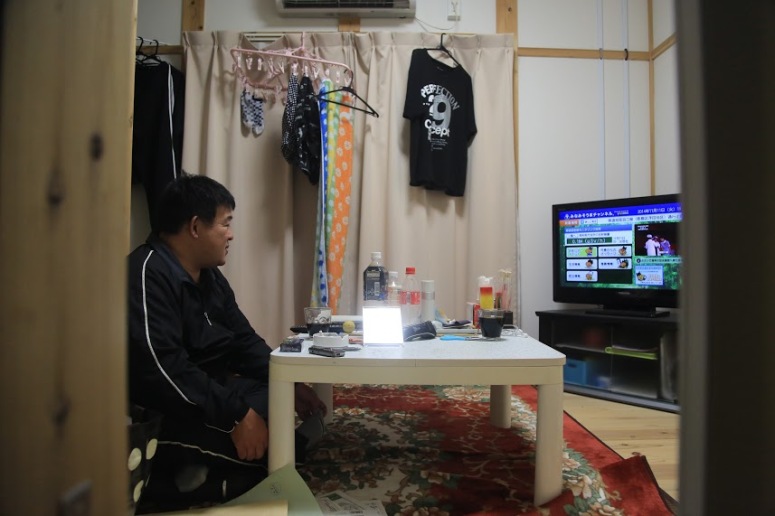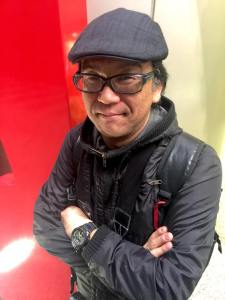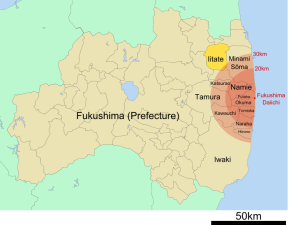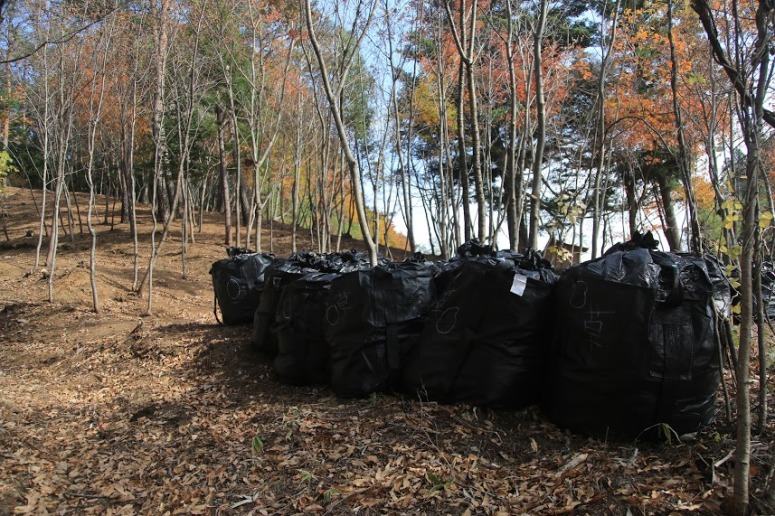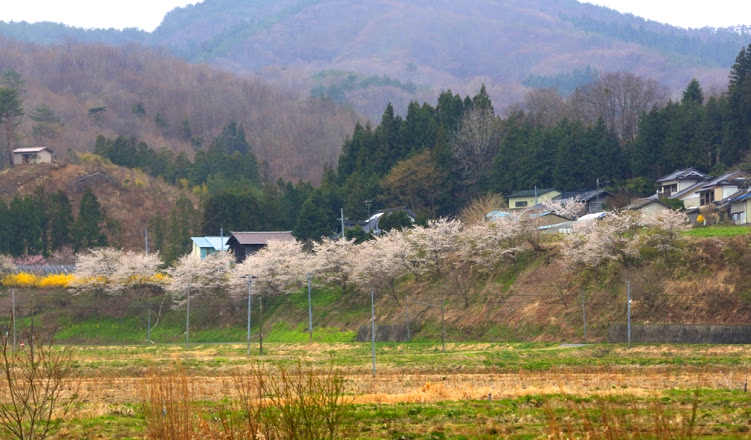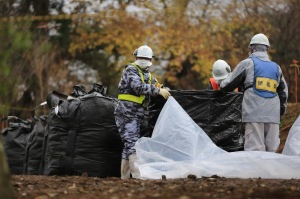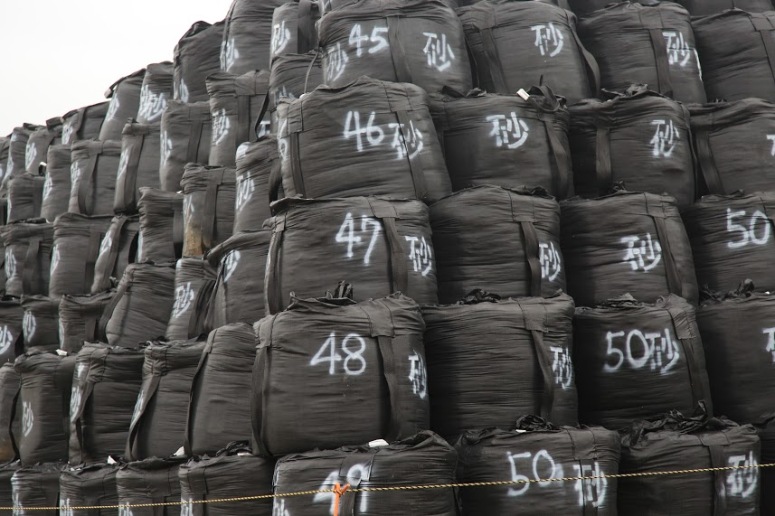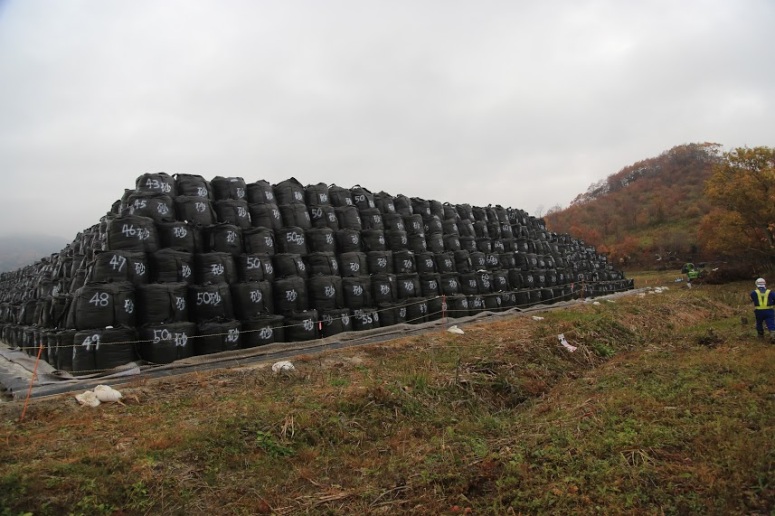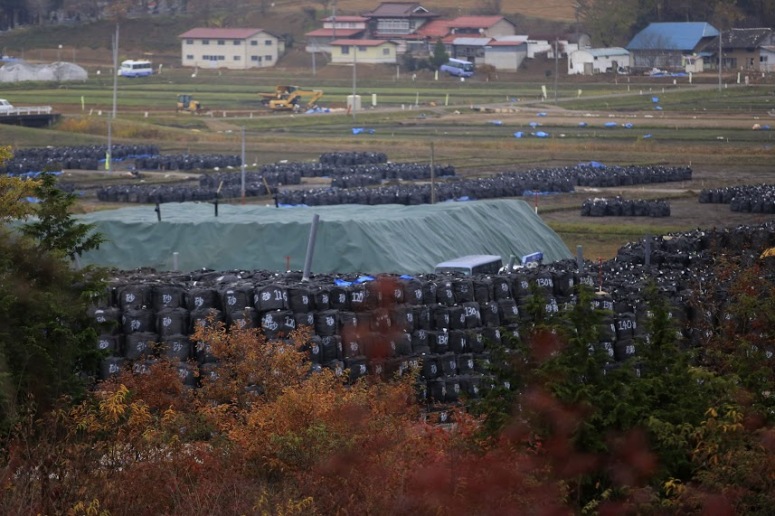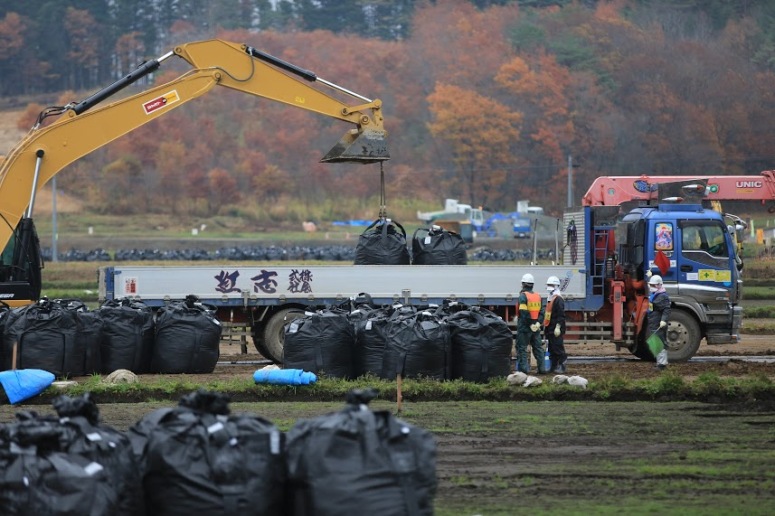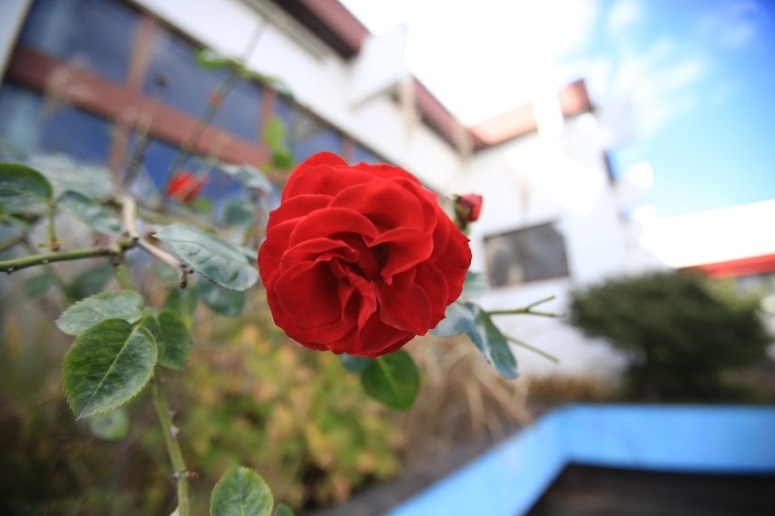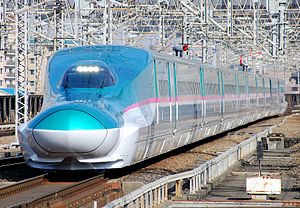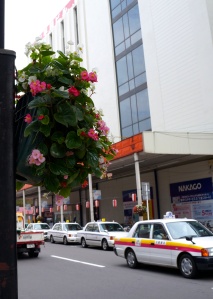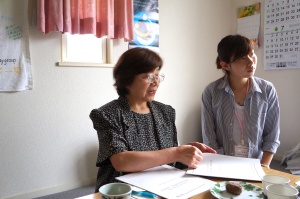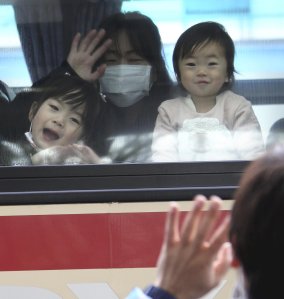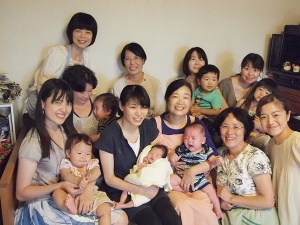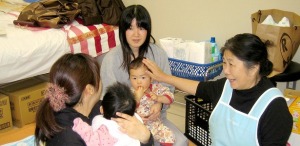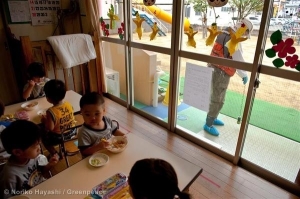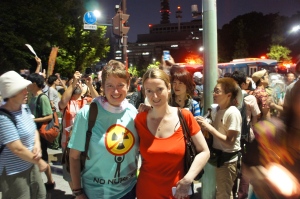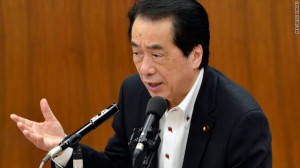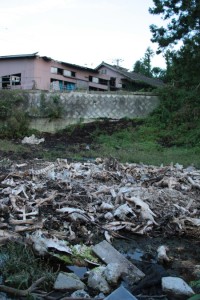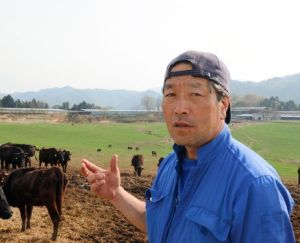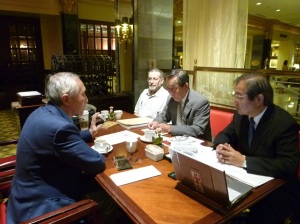A Japanese man sits on the floor of a 4-mat-sized room, staring at a TV set neatly fitted into a corner. There’s enough room for the man, the TV, and a low plastic coffee table. Clean clothes and hung on hooks along the wall, and laundry hangs from the curtain rail. What’s the story here?
I asked that question to photo journalist Hiro Ugaya as we pored over his photos from a recent trip to Fukushima. “He’s an old friend,” said Hiro, “whose wife and son have evacuated to Yamagata. He’s been looking for work for six months, but the only available jobs are related to decontamination or decommissioning of the crippled nuclear power plant, and he doesn’t want to resort to either of those options. Still, as bad as the situation is in Fukushima, the economy’s worse in Yamagata, so he stays where he is.”
Hiro, a native of Kyoto living and working in Tokyo, has made nearly 50 trips back and forth to Fukushima since the triple disaster of 3/11, capturing scenes of life near the evacuation zone with his trusty Canon 5D Mark 3. Read more about him here. He travels alone, going as far north as possible by train and then renting a car in Fukushima to drive along the coast. This month, he visited his friend Watanabe-san (pictured above), and stayed at a local hotel filled with temporary workers hired from all parts of Japan to do decontamination work in the outer regions of the evacuation zone. “Business is booming,” said Hiro, “but only if you want to work in irradiated areas.”
Although Hiro took hundreds of photos from the various coastal towns near the disabled Daiichi power plant, I want to focus mainly on his photos from Iitate Village. They reflect the slow but steady progress of the Herculean task of decontamination and serve as a sobering reminder of the sheer ugliness and shame of what happened in Fukushima. All photos in this post are Hiro’s, and all but one are from his recent November trip.
Iitate Village (pronounced EE-ta-tay), a highland farming area northwest of the crippled nuclear power plant, lies outside of the designated 30 Kilometer radius of the government-determined evacuation zone. But those of you who have followed the story, know that on March 15th, a gusty winter wind blew particles of radiation straight toward the mountains of Iitate. The wind was accompanied by snow, which blanketed the entire area. Stores, schools, houses, trees, rice paddies, vegetable gardens, and grazing pastures were all heavily contaminated, though no-one guessed at first because of the village’s physical distance from the center of the nuclear disaster. Of course, the evacuation map was drawn as a perfect circle, with multiple rings indicating distance from the radius, and Iitate was far from that radius. If only radiation travelled so neatly, without regard to weather or topography, right?
The evacuation of Iitate did not begin until April 22nd (over a month after the meltdown and the explosions occurred) and was not finished until late August of 2011; residents were inadvertantly exposed to high levels of radiation as well as emotional stress and confusion. For many of the elderly people who evacuated from Iitate and are still in temporary housing, living with depression, disappointment, and lingering sadness has become the new normal. Worse yet, residents from towns near the epicenter of the accident were also exposed to excess radiation when they were initially relocated to Iitate, which was considered a safe refuge shortly after the meltdowns. This was a tragedy that could have been prevented if the central government (not wanting to “incite panic”) had released a map known as SPEEDI, containing specific data regarding the path of the plume of radioactivity. You can read about it here, in an early blog entry from 2012.
So what’s the story on Iitate now, more than three years down the road? Well, some readers may be surprised to learn that although the level of radiation in many areas of Iitate remains high, the village is no longer “off-limits”. Former residents can now come and go freely and decontamination work is progressing–slowly, painstakingly–in hopes that the village will be revitalized. The mayor is determined that it will be. The problem is that Iitate is bordered by forestland. Since the nuclear disaster, trees are now cesium repositories, and many traditional houses in the village are situated in close proximity to sheltering groves, which serve as windbreaks. The trees that once sheltered homes have now contaminated them, and they are uninhabitable.
The central government does not consider forestland “residential”, and does not place a high priority on decontamination of the trees that define residents’ backyards. The reality is that many local residents must either abandon their homes, or attempt to “clean” the forestland lying closest to their houses, essentially stripping the forest of its ecosystem. Think of Iitate as a mountainous forest which humans have made habitable by clearing and cultivating the land for generations. Now it is
impossible to guarantee the safety of the land for humans without destroying the ecosystem itself, which is steeped in cesium, from the shiitake mushrooms that flourish in the contaminated forest to the wild boars that feed on the mushrooms. Cesium from the forest is carried down to the village with each rain or snowfall, and previously cleared terrain is re-contaminated. On the flat areas below the forest, work progresses at a painfully slow rate, and deadlines that prove impossible to adhere to are continually being re-assessed and re-determined. Booming business for the decontamination workers means a longer exile for residents still hoping to return in the near future.
The above assessment sounds and is harsh, but there is another vision. Many residents of Iitate and of similar small villages and towns in Fukushima believe that the land can be rescued and revitalized without destroying the ecosystem. You can read more about them in this transcript of an NHK broadcast from December 2013. Although the English translation reads imperfectly, the photos, personal stories and quotes from local residents gathered by Swiss journalist Susan Boos are food for thought.
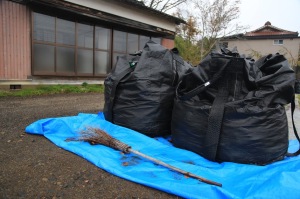
Decontamination means plant life is cut down or pulled up, and topsoil is dug up and bagged neatly .
Unlike the land around the Chernobyl nuclear disaster site, which was left to revert to its natural state, Fukushima’s contaminated areas are being stripped, scrubbed, plowed, drained, and stirred up; Boos wanted to know why. The transcript describing her visit to Iitate Village is interesting because it makes no mention of the decontamination work being funded by the central government, focusing instead on the efforts of individual farmers who have lived and worked in Iitate for generations. Frustrated with the slow pace of the clean-up, Iitate residents have been doing things their own way, taking detailed measurements of radiation levels, creating radiation maps, and developing alternative methods for reducing the effects of cesium in the soil.
“From now on,” says Iitate farmer Muneo Kanno in the transcript, “we will need to coexist with nature in this contaminated area over many generations. In other words, I think it’s our job to collect all the data we can about contamination and pass it on to the future generations….I strongly believe that this is the first and foremost role both for me and all the other local people.”
Kanno and other volunteer farmers and researchers are committed to accurately evaluating the state of their land, recording their findings, and experimenting with solutions. For them, decontamination is “Not just to remove everything, to wash, to brush and to think now the problem is done.” Boos, who has travelled the world reporting on the conditions of nuclear disaster sites, was deeply impressed by the devotion of the Iitate farmers to their land and by their determination to preserve it for future generations. The transcript reads, “Susan has travelled to many parts of the word, but this is the first time for her to be exposed to such deep affection for someone’s home.”
So who actually lives in Iitate Village right now? As of September 2014, a few hundred people have received permission to return home permanently, based on the location of their land. They are living in the zone that’s deemed “safe”, or at least”safe enough”. The area of Iitate still under decontamination and deemed “uninhabitable” is populated by day-trippers (former residents who commute into the village weekly–or even daily– to check on their houses, pets, or gardens), professional contamination workers, and the occasional journalist like Hiro, collecting stories, measuring radiation, and snapping pictures. It’s a ghost town at night.
On his most recent trip to Fukushima, Hiro, as I mentioned in the beginning of this post, stayed in a local hotel south of the Daiichi nuclear power plant. “I was lucky to get a room,” he said. “It’s always full these days. All guys, and all working in decontamination. ” Since there were no restaurants in town (read: nuclear zone, no tourists), Hiro and the other workers made a mad rush to the 7-11 , which closed at 8 p.m., to buy box lunches for their dinner every evening. According to Hiro, the going rate for a decontamination worker in Fukushima right now is around ¥16,000 to 17,000a day–approximately $145 U.S. dollars– before money is taken out by contractors and sub-contractors. Is it worth the money? That’s something that every man ( I saw no women in any of the photos) must come to terms with on his own.
From here on in, I will let Hiro-san’s photos speak for themselves. You can read more about Iitate’s mountains of trash bags full of contaminated soil in this Japan Times article, which describes the current plan to build a 22 million cubic meter temporary waste storage facility in the Okuma/ Futaba area, home of the crippled power plant. That’s a space big enough to fill the Tokyo Dome Stadium 15 times. And you can read more about the plight of the old folks who have evacuated from Iitate and other neighboring towns in this article by The Guardian’s Justin McCurry. And you can support the excellent work of free lance journalists like Hiro Ugaya by passing on their words and images. Take a look at more of his stunning photos and read about his life here. I’ll post some of my favorites as well. Thank you for reading, and take care.
